Top 15 Worst Practices in Business Intelligence Implementation
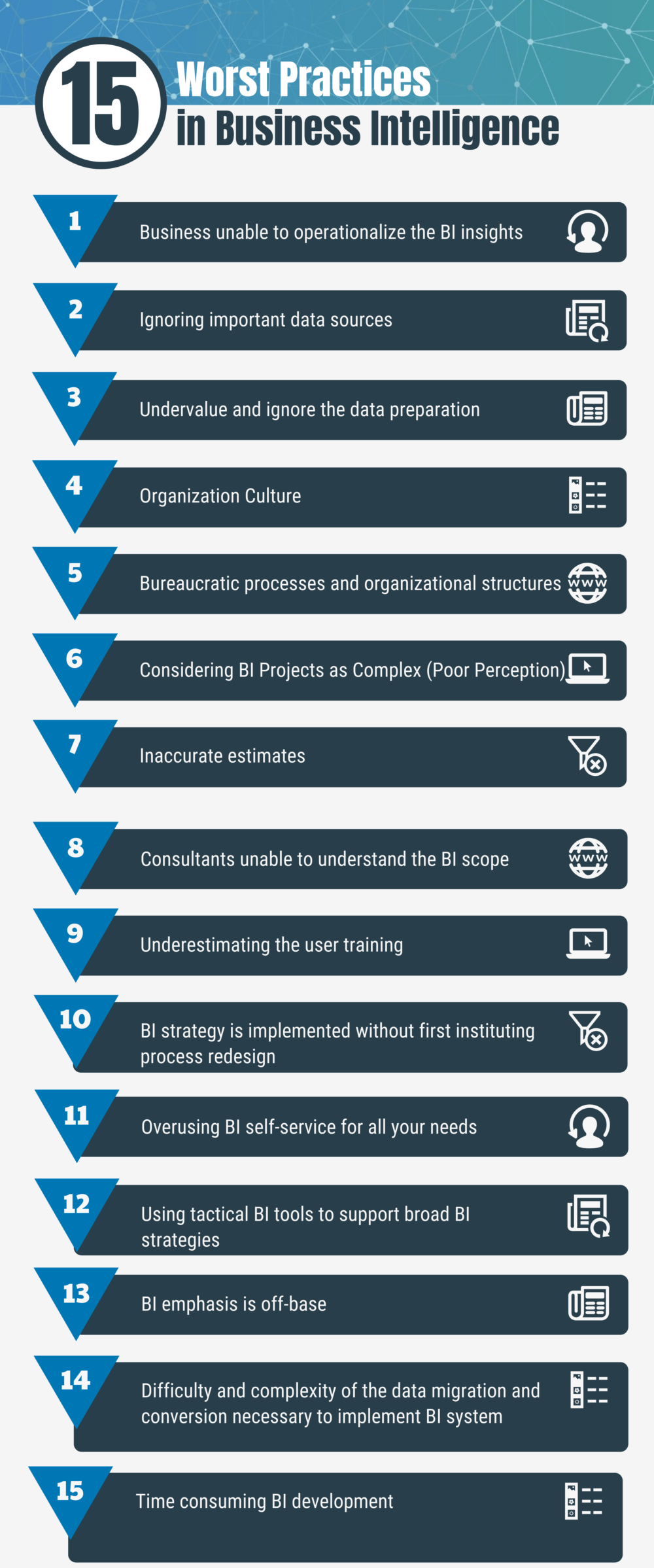
Business Intelligence refers to technologies, applications, and practices for the collection, integration, analysis, and presentation of business information. The purpose of Business Intelligence is to support better business decision making.
Business Intelligence (BI) refers to the technologies, tools, and practices used by organizations to gather, store, analyze, and provide access to data to inform decision making. BI enables businesses to turn data into actionable insights and drive growth by providing a complete view of the organization's performance, including historical trends and real-time data analysis. The key components of BI include data warehousing, data mining, and reporting, dashboards, and visualization. The goal of BI is to provide organizations with a centralized platform for data integration, analysis, and visualization to support informed decision making and drive business growth. With the rise of big data, cloud computing, and advanced analytics, BI has become an essential tool for organizations looking to stay ahead in today's fast-paced business environment.
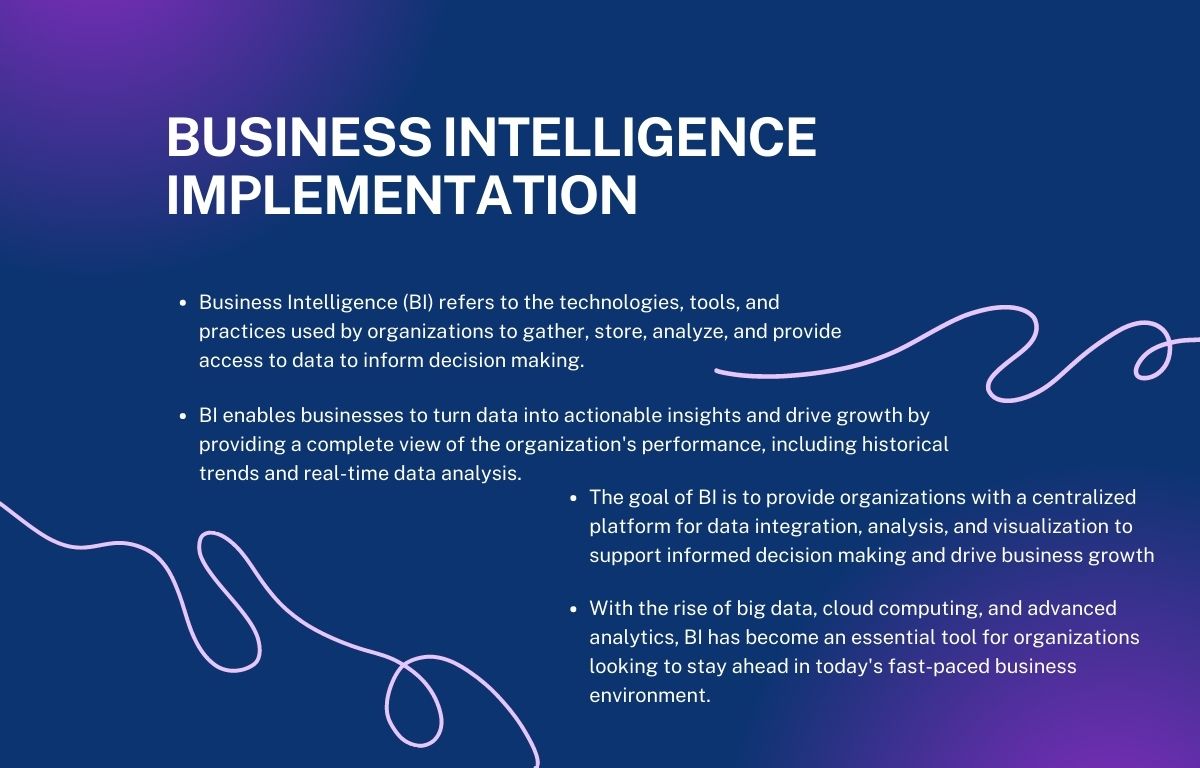
Worst Practices in Business Intelligence Implementation
BI provides the means for analyzing it to give companies a better understanding of how their business processes are actually executed. Business Intelligence systems beneficiaries include group of users starting from specialists in financial reporting, marketing and salespeople, supply chain, operations and logistics and up to members of the board. BI systems represent an integrated environment that mainly consists of data warehouses, ETL tools, OLAP techniques and data mining.
Sometimes our expectations might be higher than what we can anticipate; this theory also applies to some business intelligence (BI) implementations. Studies have been conducted and on such, and about 60 percent of the companies were pleased by the success they achieved with BI.
You may like to read: Top Best Practices for Business Intelligence Software Implementation
Most businesses have suffered from countless challenges such as selection of the tool; poor judgement calls when planning and rollout mistakes which may be an issue to the success of BI. To an extent, even the successful small businesses have come to terms that breakdowns and shelfware cause BI project failure.
Top 15 Worst Practices in Business Intelligence Implementation
There are several worst practices that can negatively impact the implementation of Business Intelligence (BI) solutions. Firstly, neglecting the importance of data governance and failing to establish clear data ownership and stewardship can lead to poor data quality and inaccurate insights. Secondly, not involving stakeholders and end-users in the BI implementation process can result in solutions that are not aligned with business needs and not adopted by the organization. Thirdly, relying solely on technology to solve business problems and neglecting the importance of change management can lead to ineffective solutions and low user adoption. Fourthly, neglecting the importance of data integration and failing to cleanse, standardize, and integrate data from multiple sources can lead to inaccurate insights and poor decision-making. Finally, not considering the long-term scalability and maintenance of BI solutions can lead to a lack of sustainability and the need for constant upgrades and replacements. By avoiding these worst practices, organizations can ensure a successful implementation of BI solutions that drive business growth and improve performance.
BI Worst Practices 1 - Business unable to operationalize the BI insights
Business often talks about operational insights which mean the ability to align the behaviors and expected outcomes using information strategically. BI offers significant insights that give essential facts, in turn, it doesn’t provide guidelines on turning the insights into actions. Ultimately that falls to the business users where if they don’t interpret and analyze the ideas well it might lead to consequences.
Therefore a good BI strategy is one that not only give insights on handling something but also assigning tools to help you understand and who to use it to get your desired output. The BI should also ensure that the insights are not only available to business users and analysts but also available to decision-makers, executives and stakeholders. To convert an idea into action, it takes processes, technology, metrics and governance structure.
To optimize your insights, BI strategy should empower the users on making on creating an impact from the insights and comprehensive platform that gives insights. The platform should be able to support strategic planning than execution to meet the objectives and enhance decision-making by monitoring the significant indicators and metrics.
You may like to read: The Guide to Agile Business Intelligence
BI Worst Practices 2 - Ignoring important data sources
Most of the business users tend to focus on information only in data warehouses, databases, ERP and CRM. Other data sources contain vital information that may be crucial to the organisation such as mobile, web monitoring data and social media.
Over 90 percent of data today is unstructured, can be in a different format and from anywhere. At times a business may miss out insights from a customer who might have opted to share his/her sentiments on of Twitter or Facebook. Others like location data enhancers which can be used to show market patterns and service consumption in a particular region. Only one-third of the unstructured data is being used by business for decision- making. Companies should ensure they utilise all the data available, either unstructured or structured and make them available for analysis.
You may like to read: Top Best Practices in Dashboard Software
BI Worst Practices 3 - Undervalue and ignore the data preparation
Bad decisions in a company may be due to inadequate data. When you apply bad data in BI that will undoubtedly cause disaster, even if you have compelling analytics if you’ll still have problems if your data is bad. Your users will have issues on decision-making because the data is flawed and BI team will be spending hours cleaning the data instead of working in the end-user environment.
Before data reaches to end-users, you can incorporate master data management or data quality management to enable identification and correction of wrong data.
To ensure accuracy and consistency thought data optimization for analysis, capabilities such as cleansing, matching and profiling are essential. Skills such as self-service data preparations are crucial because it ensures that data is analytic-ready, without burdening IT for data assets management. You should ensure that your technologies have features that enable efficient aggregation and standardization of information before delivery.
BI Worst Practices 4 - Organization Culture
It can significantly affect the duration of implementation. If an organisation takes dwells on individual capability, decision making and problem-solving the implementation will take longer. Many employees believe that when BI strategies are implemented these will bring about job restructuring, but indeed the tool will assist in making a strategic decision by providing analyzed data.
You may like to read: Top Best Practices in Reporting Software
BI Worst Practices 5 - Bureaucratic processes and organizational structures
Such structures can slow implementation of BI strategies and discourage natural enthusiasm in other users for a new approach, despite executive support. In large organizations, users have started looking for other ways around the BI systems due to the complexity of compliance and architecture. The so-called creativity can work against BI implementation in large organizations.
BI Worst Practices 6 - Considering BI Projects as Complex (Poor Perception)
Many organizations believe that BI tools are sophisticated to use and require high IT technical skills to implement and forget the business goal. Therefore, teams with less technical expertise tend to shun away from using BI tools which in turn drags the implementation of the project to the organisation.
BI Worst Practices 7 - Inaccurate estimates
As stated earlier inaccurate data may delay the project scope so is incorrect estimates. Inaccurate estimates can hold back the implementation cycle in cases where the estimates tend to differ when the BI project is implemented. If a project proposed BI tool can deliver nine conversions, and it’s discovered that it requires 20 conversions, this changes the project scope and affects the implementation.
You may like to read: Top Challenges every organization face in Business Intelligence
BI Worst Practices 8 - Consultants unable to understand the BI scope
At times consultant may hinder BI implementation in an organisation, this is due to lack of understanding the goals and the culture of the organisation. Some consultants are money oriented thus they will lengthen the implementation period instead of finding what’s important to change to accelerate productivity in the organizational goals.
BI Worst Practices 9 - Underestimating the user training
Most organizations often don’t train their business users, how to use the BI tools in which they end up facing issues when implementing the new solution. Before any project starts, the organisation needs to offer training to stakeholders, end-users and other personnel and involve the users throughout the implementation of the project.
You may like to read: Open Source, Free and Top Dashboard Software
BI Worst Practices 10 - BI strategy is implemented without first instituting process redesign.
Little change is accomplished when a business tries to rework a BI software to accommodate process instead of redesigning the operations in the first place. This operation takes a lot of time, and the activities are unproductive. In which the time could have spent in accomplishing productive organizational goals.
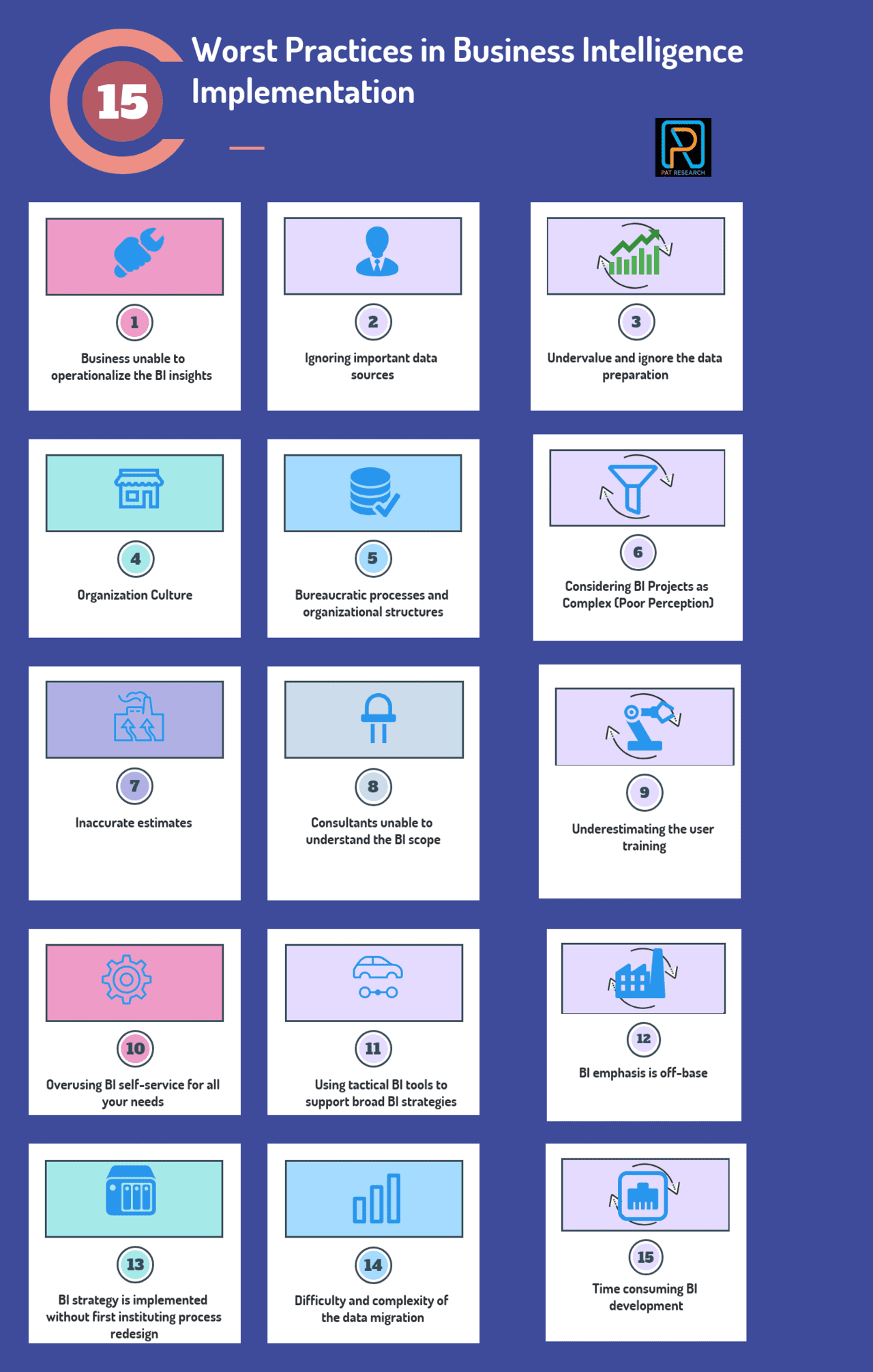
Guide for Worst Practices in Business Intelligence Implementation
BI Worst Practices 11 - Overusing BI self-service for all your needs
Self-service in BI is very important because it enables non-technical customers, employees and business partners to be able to analyze information when they need it. Even though self-service BI is considered pervasive, some businesses make mistakes of deploying environments assuming it will satisfy everyone but only end up satisfying a portion.
You need to know what kind of self-services required and what exactly your workers need because different users require different self-service approach. BI self-service should be your entire strategy, but part of your strategy and that’s the mistake most business make when purchase single self-service tool. Different users operationalize and consume data in different ways.
Thus advance users and manipulate data in sophisticated ways using sophisticated tools to produce reports while non-technical individuals use straightforward applications to attain their analytic needs. The stakeholders might require reports and scorecards when critical issues occur, and they might need it in real-time. BI strategy ought to meet the needs of all diverse population through its powerful yet feature-rich capabilities.
You may like to read: Top Guidelines for a Successful Business Intelligence Strategy
BI Worst Practices 12 - Using tactical BI tools to support broad BI strategies
BI strategies are developed to help the whole organization and not department because with it should address the broad spectrum of the enterprise and deliver value. Most businesses use tactical solutions to build their BI strategies.
Tools such as data discovery tools which can help generate reports and analysis are complex to the typical business user. Only analysts and specialists have the knowledge to work on them, leaving other such as partners, customers executives who make a large percentage of the business are in the dark. Only a few in the organization are satisfied thus resulting in low ROI.
BI tools offer a solution and assist users with simple ways of interacting with sophisticated analysis. They provide convenience to non-techies and stakeholders an opportunity to perform analysis on the simplest way to drive improvements. Even though complex information requires advanced analytical to satisfy them, most business users need data to be delivered most straightforwardly so that it may be easy to put into action.
BI Worst Practices 13 - BI emphasis is off-base
An organisation may come up with strategies that they believe will enable them to meet their goal, but when choosing a BI system, the emphasis is off-base. Businesses spend a tremendous amount of time not leveraging vendor’s expertise instead driving custom vendor modification, in which it decreases the productivity of the business implementation efforts.
BI Worst Practices 14 - Difficulty and complexity of the data migration and conversion necessary to implement BI system
The lack of supervision or personnel established to oversee the data conversion process may affect the implementation process. As stated earlier bad data means terrible results the organisation needs to set skilled to supervise the conversion and one who can handle the difficulty that comes with data migration to the new system. It will reduce the additional cost of overruns and missed deadlines on the implementation of BI
BI Worst Practices 15 - Time consuming BI development
Business might envision the BI development to take few weeks, in which the development of an interface to achieve business milestone takes efforts and time. Planners evaluate based on estimates, highest system level. In the process, their might occur transactional levels delays as a surprise which may add more weeks to the implementation of the BI strategy.
You may like to read: Why Small Businesses Need Business Intelligence Software
Conclusion
Some of the practices mention here seem like common sense, but these practices frequently occur than expected. It's easy to get caught up in the hype of new BI tool when it is continually being promoted in adverts. But now that you are aware of the worst practices you can avoid them and see your business succeed.
Here are the trending and the top rated Business Intelligence Software for you to consider in your selection process:
What is Business Intelligence?
Business Intelligence refers to technologies, applications, and practices for the collection, integration, analysis, and presentation of business information. BI provides the means for analyzing it to give companies a better understanding of how their business processes are actually executed. Business Intelligence systems beneficiaries include group of users starting from specialists in financial reporting, marketing and salespeople, supply chain, operations and logistics and up to members of the board.
What are Worst Practices in Business Intelligence Implementation?
Most businesses have suffered from business unable to operationalize the BI insights, ignoring important data sources, undervalue and ignore the data preparation, organization culture, bureaucratic processes and organizational structures, considering BI Projects as complex (poor perception) and inaccurate estimates and many more.
You may also like to read, Top Business Intelligence companies , Top Open Source and Free Business Intelligence Software , Cloud – SaaS – OnDemand Business Intelligence Solutions , Top Free Extract, Transform, and Load, ETL Software , Freemium Cloud Business Intelligence Solutions , Top Embedded Analytics Business Intelligence Software , Top Dashboard Software , Top Enterprise Performance Management Software ,Top Data Visualization Software,Top Business Intelligence Tools,Top Supply Chain Analytics Software,Top Conjoint Analysis Software,Top Unified Modeling Language (UML) Tools ,Top Mobile Business Intelligence Software ,Top Balanced Scorecard Software , Top Advertising Analytics Software and Top Business Process Management Software .

























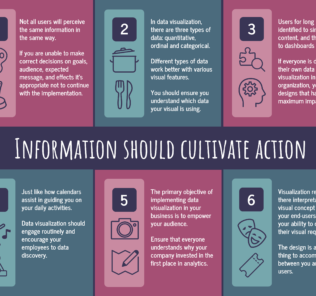
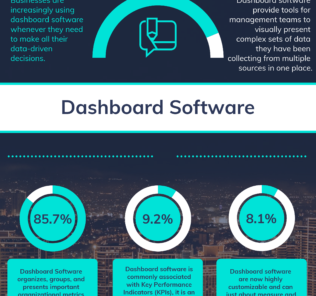
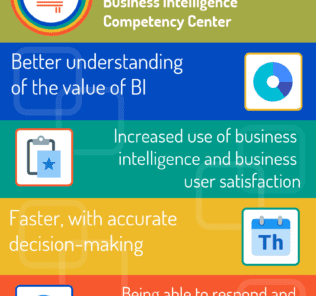
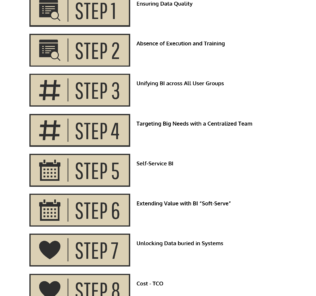
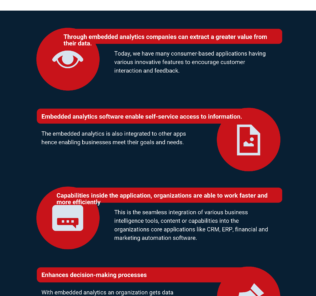
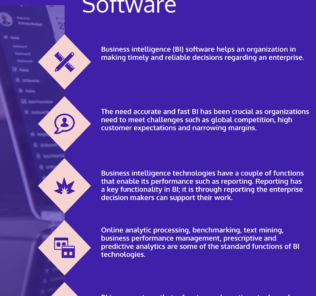




By clicking Sign In with Social Media, you agree to let PAT RESEARCH store, use and/or disclose your Social Media profile and email address in accordance with the PAT RESEARCH Privacy Policy and agree to the Terms of Use.